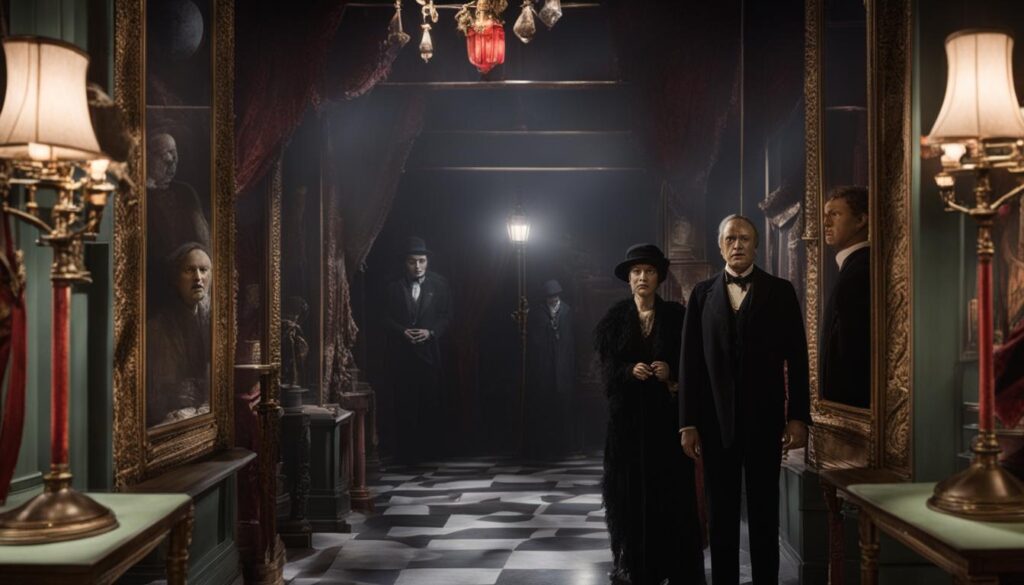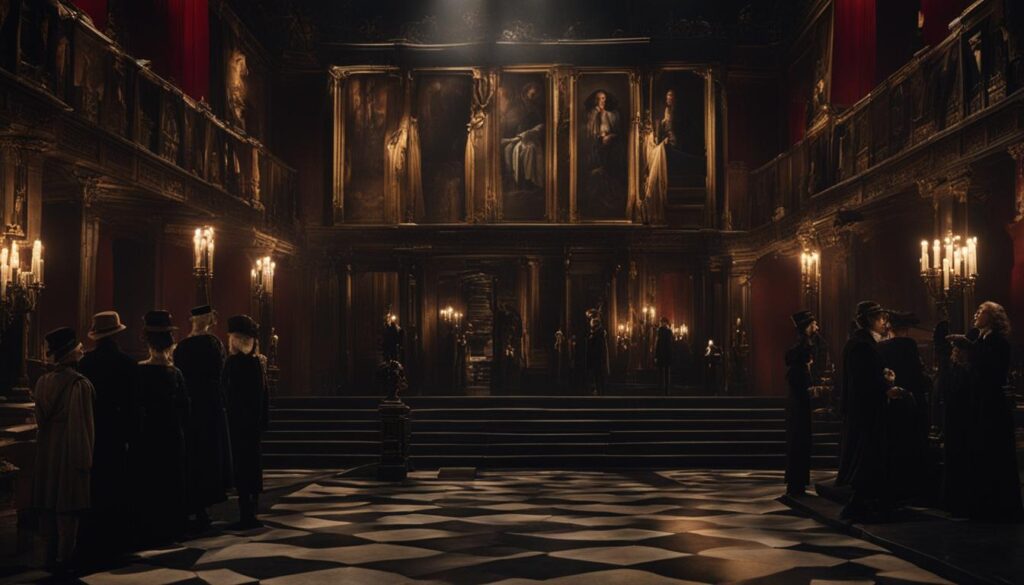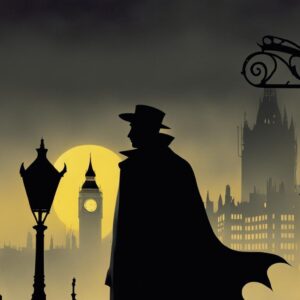As a film enthusiast, I am always on the lookout for hidden gems that have made a significant impact on the world of cinema. One such gem is Waxworks (1924), a German expressionist film and a silent horror movie directed by the visionary Paul Leni. This anthology film takes us on a surreal journey through fantastical tales centered around historical figures, showcasing the power of visual storytelling in a mesmerizing way.
Key Takeaways:
- Waxworks (1924) is a German expressionist film, known for its surreal and fantastical elements.
- It is a silent horror movie that takes the audience on a captivating journey through three stories, each centered around a different historical figure.
- The film’s visual storytelling and atmospheric cinematography create a dark and eerie atmosphere, adding to the overall immersive experience.
- Waxworks (1924) had a significant influence on the development of German expressionism and the horror genre in cinema.
- Its legacy is still felt in modern filmmaking, showcasing the lasting impact of this cinematic masterpiece.
The Plot and Characters of Waxworks (1924)
Waxworks (1924) is a captivating silent horror film that takes us on a journey through the mysterious corridors of a wax museum. The story revolves around a man who enters the wax museum and encounters three life-sized statues of historical figures. As the man interacts with the statues, they magically come to life, drawing him into their twisted and dark tales.
The film showcases the beauty of visual storytelling, as the audience is transported into the surreal and fantastical worlds of each historical figure. From the torrid love affairs of the infamous Caliph Harun al-Rashid to the chilling and murderous escapades of Jack the Ripper, Waxworks (1924) offers a unique blend of historical fiction and horror elements that keep viewers on the edge of their seats.
One of the standout performances in the film is by Conrad Veidt, who portrays Ivan the Terrible. Veidt’s captivating performance brings an eerie and menacing presence to the screen, perfectly embodying the evil and complexity of the historical figure. Through his impeccable acting, Veidt adds depth and intrigue to the character, leaving a lasting impression on the audience.
The Characters of Waxworks (1924)
| Statue | Historical Figure | Actor |
|---|---|---|
| 1 | Caliph Harun al-Rashid | Emil Jannings |
| 2 | Jack the Ripper | Werner Krauss |
| 3 | Ivan the Terrible | Conrad Veidt |
Waxworks (1924) takes the concept of a wax museum and transforms it into a nightmarish and captivating cinematic experience. With its visually stunning storytelling, haunting visuals, and captivating performances, this silent horror film continues to mesmerize audiences to this day.
The Atmosphere and Visuals of Waxworks (1924)
Waxworks (1924) is a German Expressionist film that captivates audiences with its dark atmosphere and eerie calm. The film masterfully builds up tension, leading to a climactic finale that leaves viewers on the edge of their seats. The visual elements of Waxworks play a crucial role in creating an overwhelming sense of evil surrounding the historical figures.
Conrad Veidt’s performances in Waxworks are particularly noteworthy. His ability to convey complex and evil characters through body language and expressions adds depth to the storytelling. Veidt’s portrayal of Ivan the Terrible, one of the historical figures in the film, is chilling and unforgettable.
To immerse the audience in the atmosphere of Waxworks, German Expressionist techniques are used, such as distorted set designs and atmospheric lighting. These elements contribute to the film’s surreal and fantastical ambiance, enhancing the overall viewing experience.
The combination of the dark atmosphere, eerie calm, and Conrad Veidt’s captivating performances makes Waxworks (1924) a visually stunning masterpiece that showcases the artistry and creativity of German Expressionism in cinema.
The Influence of Waxworks (1924)
Waxworks (1924) is widely recognized for its significant influence on German expressionism and the development of the horror genre in silent cinema. Directed by Paul Leni, this visually stunning film broke new ground in terms of visual storytelling and surreal elements.
The German expressionist movement, characterized by distorted sets and atmospheric lighting, found its epitome in Waxworks. The film’s use of these techniques created a dark and eerie atmosphere that set it apart from other films of its time. This distinctive visual style would go on to influence future filmmakers, shaping the direction of German expressionist cinema.
Furthermore, Waxworks (1924) played a crucial role in the evolution of the horror genre. By delving into the stories of infamous historical figures and weaving their tales into a captivating anthology film, Waxworks established a template for the exploration of psychological horror and the chilling depths of human nature. The film’s innovative approach to horror storytelling continues to inspire filmmakers today, making it a cornerstone of the genre’s development.
In summary, Waxworks (1924) left an indelible mark on the cinematic landscape. Its visual storytelling techniques, rooted in German expressionism, revolutionized the way stories were told on the silver screen. This influential film paved the way for future horror classics and remains an essential piece of silent cinema history.
The Legacy of Waxworks (1924)
Waxworks (1924) is regarded as a cinematic masterpiece and a significant contribution to the silent horror film genre. Its unique blend of German expressionism, surreal visuals, and historical storytelling has influenced filmmakers throughout the years. The film’s impact can still be seen in modern cinema, particularly in the use of visual storytelling to create atmospheric and immersive experiences for the audience.
The film’s legacy lies in its ability to captivate and inspire audiences with its innovative approach to storytelling and its haunting visuals. Waxworks (1924) paved the way for future filmmakers to experiment with surrealism and fantastical elements in their work, pushing the boundaries of cinematic storytelling. Its influence can be seen in iconic horror films such as Nosferatu (1922) and The Cabinet of Dr. Caligari (1920), which also employed German expressionist techniques to create a sense of unease and fear.
One of the film’s lasting legacies is its impact on visual storytelling. The use of elaborate set designs and atmospheric lighting in Waxworks (1924) set a precedent for future filmmakers in creating immersive and visually stunning cinematic experiences. The film’s portrayal of historical figures through a mix of reality and fiction also contributed to its lasting influence, showcasing the power of storytelling to shape our understanding of the past.
| Legacy of Waxworks (1924) | Keywords |
|---|---|
| Influential cinema | Waxworks (1924), silent horror films, German expressionism |
| Cinematic masterpiece | Waxworks (1924), visual storytelling |
The enduring legacy of Waxworks (1924) can be attributed to its ability to transport audiences into a world of surreal beauty and horror. The film’s striking visuals and innovative storytelling techniques continue to inspire filmmakers and cinephiles alike, solidifying its status as a true cinematic masterpiece.
The Impact on Cinematic Storytelling
Waxworks (1924) revolutionized cinematic storytelling through its use of visual techniques and atmospheric storytelling. The film’s ability to create a sense of dread and unease through its visuals and performances remains unmatched. Filmmakers today continue to draw inspiration from the film’s unique blend of historical fiction, visual storytelling, and suspenseful narratives.
In conclusion, Waxworks (1924) has left an indelible mark on the horror genre and cinematic history as a whole. Its influence can be seen in countless films that have followed, as well as in the continued fascination with German expressionism and visual storytelling. As a cinematic masterpiece, Waxworks (1924) will forever be remembered for its innovative approach to silent horror and its enduring legacy in influential cinema.
The Performances in Waxworks (1924)
When it comes to the performances in Waxworks (1924), the actors truly shine in bringing the complex and evil characters to life through silent acting. Emil Jannings, Conrad Veidt, and Werner Krauss deliver captivating performances that leave a lasting impact on the audience.
Emil Jannings, known for his expressive acting style, delivers a compelling performance in Waxworks. His portrayal of the characters, ranging from a menacing Ivan the Terrible to a mysterious Caliph Harun al-Rashid, showcases his versatility as an actor. Jannings’s ability to convey emotions through subtle gestures and facial expressions adds depth and nuance to each character he portrays.
Conrad Veidt’s portrayal of Ivan the Terrible is particularly mesmerizing. His commanding presence and chilling intensity captivate the audience, making Ivan a truly memorable and complex figure in the film.
Werner Krauss also deserves recognition for his role as Jack the Ripper in Waxworks. His portrayal of the infamous serial killer exudes menace and darkness, creating a sense of unease throughout the film. Krauss’s physicality and emotive expressions make Jack the Ripper a truly haunting presence on screen.
Overall, the performances in Waxworks (1924) elevate the film to new heights, showcasing the power of silent acting and the talent of actors such as Emil Jannings, Conrad Veidt, and Werner Krauss.
Waxworks (1924) as an Anthology Film
Waxworks (1924) is a fascinating example of an anthology film, presenting three distinct stories that revolve around different historical figures. Each story is intricately crafted to provide a unique narrative experience, while also weaving together in an overarching structure. This anthology format allows the film to explore various time periods, genres, and themes, offering a rich tapestry of storytelling.
One of the notable aspects of Waxworks is its portrayal of historical figures. Each story focuses on a different iconic figure, such as Ivan the Terrible, Jack the Ripper, and Harun al-Rashid. Through these characters, the film delves into their dark and complex histories, showcasing their impact on society and the lasting fascination they hold. The intertwining of these narratives adds depth and context to each individual story, creating a cohesive and engaging experience for the audience.
With its anthology structure, Waxworks captivates viewers by presenting a diverse range of genres and styles. Each story has its own distinct tone and atmosphere, reflecting the unique characteristics of the historical figure it portrays. From the eerie calm of the Ivan the Terrible segment to the suspenseful hunt for Jack the Ripper, the film keeps audiences on the edge of their seats, never knowing what story awaits them next. This variety of storytelling adds depth and intrigue to the overall film, ensuring that there is something for everyone to enjoy.
Throughout Waxworks, the intertwining narratives and exploration of historical figures provide a thought-provoking and visually stunning experience. The film’s anthology format allows for a deeper understanding of these iconic figures, shedding light on their complexities and the impact they have on our collective imagination. Waxworks (1924) remains a true gem in the anthology film genre, offering a captivating and immersive journey through history and fantasy.
Table: Historical Figures in Waxworks (1924)
| Story | Historical Figure |
|---|---|
| Story 1 | Ivan the Terrible |
| Story 2 | Jack the Ripper |
| Story 3 | Harun al-Rashid |
The Visual Effects and Cinematography of Waxworks (1924)
One of the standout features of the film Waxworks (1924) is its impressive visual effects and atmospheric cinematography. As a prime example of German Expressionism, the film utilizes innovative techniques to create a visually stunning experience that captivates the audience.
The use of atmospheric lighting is particularly notable in Waxworks (1924). By carefully controlling the lighting and shadows, the filmmakers were able to enhance the eerie and dark atmosphere of the film. This technique adds depth and tension to the storytelling, creating a sense of overwhelming evil surrounding the historical figures portrayed in the film. The atmospheric lighting also helps to establish the surreal and fantastical elements that are a hallmark of German Expressionism.
The visual effects in Waxworks (1924) are remarkable for their time, adding a layer of magic and fantasy to the storytelling. From morphing statues to dream-like sequences, the film pushes the boundaries of what was possible in early cinema.
The visual effects in Waxworks (1924) are also remarkable for their time. From morphing statues to dream-like sequences, the film pushes the boundaries of what was possible in early cinema. These effects not only add a layer of magic and fantasy to the storytelling but also contribute to the overall surreal and fantastical atmosphere of the film.
| Visual Effects | Cinematography |
|---|---|
| The use of morphing statues | The use of atmospheric lighting |
| Dream-like sequences | Controlled use of shadows |
| Magical and fantastical elements | Enhancement of tension and depth |
The visual effects and cinematography in Waxworks (1924) contribute to the film’s lasting impact on cinematic history. By using German Expressionist techniques, such as atmospheric lighting and innovative visual effects, the filmmakers were able to create a visually stunning and immersive experience for the audience. Waxworks (1924) is a testament to the power of visual storytelling and continues to be recognized as a milestone in early cinema.
The Historical Significance of Waxworks (1924)
Waxworks (1924) holds immense historical significance in its portrayal of various historical figures and their impact on society. Through its visually stunning storytelling, the film provides insights into the artistic interpretations of historical events and personalities. Its surreal and fantastical elements, combined with captivating performances, make it a compelling representation of the cultural context in which it was made.
In Waxworks (1924), each story revolves around a different historical figure, such as Ivan the Terrible, Jack the Ripper, and Haroun al-Raschid. These portrayals shed light on the persona and actions of these individuals, revealing the complexities of their existence. The film not only invites us to explore the shadowy aspects of history but also encourages us to examine our own understanding of these figures and their cultural impact.
“Waxworks allows us to delve into the depths of history, unearthing the hidden secrets and darker sides of its protagonists. Through the art of visual storytelling, the film challenges our perceptions and forces us to confront the consequences of the actions of these historical figures. Waxworks presents a unique opportunity to experience history in a way that is both engaging and thought-provoking.” – Film critic
Moreover, the historical significance of Waxworks (1924) lies in its portrayal of the cultural and artistic movements prevalent during the time of its creation. The film embodies the spirit of German expressionism, with its dark and eerie aesthetics, distorted set designs, and atmospheric lighting. It exemplifies the artistic experimentation and innovation that defined the era, leaving an indelible mark on the development of cinematic techniques.
| Historical Significance of Waxworks (1924) |
|---|
| Offers unique artistic interpretations of historical figures |
| Sheds light on the complexities of these historical personalities |
| Challenges our understanding of history |
| Represents the cultural context of the time |
| Embodies the spirit of German expressionism |
| Leaves a significant impact on cinematic techniques |
The Soundtrack and Silent Film Experience of Waxworks (1924)
When watching Waxworks (1924), it is important to understand the unique cinematic experience that silent films offered. As a silent film, Waxworks originally had no sound accompanying the visuals on screen. However, to enhance the atmosphere and emotions portrayed, live musical accompaniment was often provided during screenings. This musical accompaniment played a crucial role in creating the desired atmosphere and immersing the audience into the world of the film.
The absence of dialogue in silent films allowed the visuals and performances to take center stage. The lack of sound encouraged filmmakers to focus on visual storytelling, relying on expressive performances, intricate set designs, and atmospheric lighting to convey emotions and tell a compelling story. Waxworks (1924) exemplifies this approach, using its surreal visuals and captivating performances to create a mesmerizing experience for the audience.
“The absence of dialogue in Waxworks (1924) allows the visuals and performances to take center stage, captivating the audience with its atmospheric storytelling.” – Film Critic
The use of musical accompaniment during screenings added another layer of depth to the silent film experience. Depending on the screening, the specific soundtrack for Waxworks may have varied, but the chosen music would always complement the visuals and enhance the emotions being portrayed. From haunting melodies to suspenseful rhythms, the soundtrack played a vital role in creating a heightened sense of atmosphere and ambiance, further immersing the audience in the world of the film.
The Impact of Music on the Silent Film Experience
Music was not just an accompaniment but an integral part of the silent film experience. It served as the voice of the film, evoking emotions, setting the mood, and guiding the audience’s emotional journey throughout the narrative. The combination of visuals, performances, and music in Waxworks (1924) created a captivating and immersive cinematic experience that continues to be appreciated by film enthusiasts today.
| Key Elements of the Silent Film Experience | Musical Accompaniment | Impact |
|---|---|---|
| Visual storytelling | The music enhances the emotions and atmosphere portrayed on screen, intensifying the impact of the visuals. | The silent film experience becomes more engaging and cinematic, drawing the audience into the story. |
| Performance | The music adds depth to the performances, highlighting the nuances and emotions of the characters. | The audience is able to connect with the characters on a deeper level and empathize with their experiences. |
| Atmosphere | The music sets the tone and creates a captivating atmosphere, heightening the suspense and drama of the film. | The audience is fully immersed in the world of the film, experiencing the intended emotions and tension. |
As we explore the legacy of Waxworks (1924), it is important to recognize the significant role that the soundtrack and the silent film experience played in shaping the overall impact of the film. The absence of sound allowed the visuals and performances to shine, while the music intensified the emotions and atmosphere, creating a truly memorable cinematic journey.
The Reception and Criticism of Waxworks (1924)
Upon its release, Waxworks (1924) garnered critical acclaim for its innovative storytelling and visually stunning presentation. Audiences were captivated by the film’s silent horror elements and the captivating performances of the actors. The film’s unique blend of surreal visuals and historical storytelling made it a standout in the silent film era.
However, like many films of its time, the reception of Waxworks varied among different audiences and critics. While some praised the film’s atmospheric cinematography and eerie atmosphere, others found fault with its unconventional narrative structure. Some critics felt that the film lacked cohesiveness as an anthology and criticized its disjointed storytelling.
Nevertheless, the overall impact of Waxworks on the horror genre and its enduring legacy cannot be ignored. The film’s contribution to the evolution of silent cinema, particularly in terms of visual effects and atmospheric lighting, solidified its place in film history. Waxworks remains a significant example of early horror films and continues to inspire filmmakers to this day.
| Year | Festival | Award |
|---|---|---|
| 1924 | Berlin International Film Festival | Best German Film |
| 1924 | Vienna International Film Festival | Grand Prize |
| 1924 | New York Film Critics Circle | Best Foreign Film |
The Restoration and Preservation of Waxworks (1924)
Preserving and restoring Waxworks (1924) is essential to safeguarding an important piece of cinematic history. This German expressionist silent horror film holds immense cultural and historical significance, making it imperative to protect its legacy for future generations. Efforts have been made to restore the film to its original quality, ensuring that its visual and storytelling brilliance can continue to be appreciated.
The restoration process for Waxworks (1924) involves meticulously repairing damaged frames, enhancing the film’s visual clarity, and preserving its original tinting and toning. This meticulous process aims to recreate the film’s original look and feel, allowing audiences to experience it as close to the director’s original vision as possible. By investing in restoration, we can truly appreciate the craftsmanship and artistry that went into creating this cinematic masterpiece.
The preservation of Waxworks (1924) not only allows us to enjoy the film’s captivating performances and intricate plotlines but also provides valuable insights into the development of early cinema. It serves as a window into the filmmaking techniques and storytelling styles of the 1920s, offering a glimpse into the evolution of the medium. By protecting Waxworks and other silent films, we can preserve a crucial part of our cultural heritage and gain a deeper understanding of the history of cinema.
Restoring and preserving Waxworks (1924) is an ongoing endeavor that requires collaboration between film archives, restoration experts, and preservationists. Through their dedication and expertise, these individuals ensure that this cinematic gem remains accessible for future generations. By saving and protecting films like Waxworks, we honor the pioneering filmmakers of the past and ensure that their contributions to cinematic history are never forgotten.
Waxworks Restoration and Preservation Table
| Restoration Process | Importance |
|---|---|
| Repairing damaged frames | Preserves the integrity of the film and ensures its longevity |
| Enhancing visual clarity | Allows audiences to see the film as close to its original quality as possible |
| Preserving original tinting and toning | Maintains the intended atmosphere and aesthetics of the film |
| Collaboration between film archives, restoration experts, and preservationists | Ensures the collective effort in protecting and restoring the film |
| Preserving cultural heritage | Allows future generations to appreciate the historical significance of Waxworks (1924) |
Waxworks (1924) and the Evolution of Cinema
Waxworks (1924) represents a pivotal moment in the evolution of cinema, pushing the boundaries of storytelling techniques and visual effects. The film’s innovative approach paved the way for future advancements in filmmaking, particularly in the realms of German expressionism and the horror genre. Through its mesmerizing visuals and captivating performances, Waxworks (1924) left an indelible mark on the history of cinema.
One of the key contributions of Waxworks (1924) to cinematic evolution lies in its utilization of storytelling techniques. The film’s anthology format, comprising three distinct stories centered around historical figures, demonstrated the potential for intertwining narratives within a single cohesive structure. This approach allowed for a deeper exploration of themes and characters, providing the audience with a rich and immersive experience.
In addition to its narrative innovation, Waxworks (1924) showcased groundbreaking visual effects that redefined the possibilities of the medium. Incorporating elements of German expressionism, the film employed distorted set designs and atmospheric lighting to create a surreal and otherworldly atmosphere. These visual techniques not only enhanced the storytelling but also served as a blueprint for future filmmakers to experiment with and expand upon.
Table:
| Aspect | Impact on Cinematic Evolution |
|---|---|
| Storytelling Techniques | Introduced the anthology format and interweaving narratives, leading to more complex and layered storytelling in future films. |
| Visual Effects | Set a new standard for the use of atmospheric lighting and distorted set designs, inspiring filmmakers to push the boundaries of visual storytelling. |
| German Expressionism | Played a significant role in popularizing the German Expressionist style and its impact on the horror genre, influencing the visual language of cinema for years to come. |
Waxworks (1924) is a testament to the power of cinema to evolve and transform. Its narrative and visual innovations continue to inspire filmmakers to this day, and its influence can be seen in subsequent works that have pushed the boundaries of storytelling and visual effects. As we reflect on the legacy of Waxworks (1924), we recognize its significance in shaping the course of cinematic history and its lasting impact on the art form we know and love.
Conclusion
After exploring the captivating world of Waxworks (1924), it is evident that this film is a true cinematic wonder. From its surreal visuals to its captivating performances, the movie continues to enthrall audiences and leave a lasting impact.
The film’s unique blend of historical storytelling and German expressionist style creates a mesmerizing experience that transports viewers to a world of fantasy and horror. The use of visual effects and atmospheric cinematography further enhances the film’s eerie atmosphere, keeping audiences on the edge of their seats.
As a reviewer, I can confidently say that Waxworks (1924) is a must-watch for any cinephile. It offers valuable insights into the evolution of cinema and showcases the boundless possibilities of silent film. The film’s legacy in the horror genre and its cultural significance make it an important piece of cinematic history.
So, if you’re looking for a truly remarkable and visually stunning cinematic experience, I highly recommend immersing yourself in the mesmerizing world of Waxworks (1924). Prepare to be captivated by its unique storytelling, breathtaking visuals, and the lasting impression it leaves on the world of cinema.
FAQ
What is Waxworks (1924) about?
Waxworks (1924) is an anthology film consisting of three stories centered around different historical figures. A man enters a wax museum and interacts with statues that come to life, each recounting their own stories filled with love affairs, murders, crimes, and chilling activities.
What is the style of Waxworks (1924)?
Waxworks (1924) has a distinct German Expressionist style, characterized by a dark and eerie atmosphere. The film utilizes visual elements, such as distorted set designs and atmospheric lighting, to create a visually stunning and surreal experience.
Who are the notable actors in Waxworks (1924)?
Waxworks (1924) features notable performances from Emil Jannings, Conrad Veidt, and Werner Krauss. These actors showcase their talent in portraying complex and evil characters through silent acting, using expressions and body language to convey a range of emotions.
How does Waxworks (1924) relate to other silent horror films?
Waxworks (1924) is regarded as a silent horror film and has had a significant influence on the development of the horror genre. Its use of visual storytelling, surreal elements, and captivating performances sets it apart from other silent films of the time.
How has Waxworks (1924) influenced cinema?
Waxworks (1924) has had a significant impact on cinema, particularly in the German expressionism movement and the horror genre. Its innovative storytelling techniques and visual effects have influenced filmmakers throughout the years, shaping the future of cinematic storytelling.
Is Waxworks (1924) a silent film?
Yes, Waxworks (1924) is a silent film originally shown without sound. Live musical accompaniment was often used during screenings to enhance the atmosphere and emotions portrayed on screen.
How has Waxworks (1924) been received by audiences and critics?
Waxworks (1924) received critical acclaim for its innovative storytelling and visual style. However, like many silent films, the reception of Waxworks varied among different audiences and critics.
Why is the restoration and preservation of Waxworks (1924) important?
The restoration and preservation of Waxworks (1924) is vital for our understanding of cinematic history. Efforts have been made to restore the film to its original quality and ensure its longevity for future generations to appreciate.
What is the legacy of Waxworks (1924) in cinema?
Waxworks (1924) is considered a cinematic masterpiece and a significant contribution to the silent horror film genre. Its unique blend of German expressionism, surreal visuals, and historical storytelling continues to influence filmmakers to this day.
Who are the main historical figures portrayed in Waxworks (1924)?
Waxworks (1924) features stories centered around three historical figures: Ivan the Terrible, Jack the Ripper, and Harun al-Rashid.
How does Waxworks (1924) contribute to the evolution of cinema?
Waxworks (1924) lays the foundation for future cinematic advancements with its innovative storytelling techniques, use of visual effects, and incorporation of German expressionist elements. It has helped shape the development of cinema as an art form.
What is the significance of Waxworks (1924) in terms of historical events and personalities?
Waxworks (1924) portrays various historical figures and their impact on society. The film serves as a representation of the cultural context in which it was made and provides insights into the artistic interpretations of historical events and personalities.
What are the visual effects and cinematography like in Waxworks (1924)?
Waxworks (1924) features impressive visual effects and atmospheric cinematography. The film utilizes German expressionist techniques, such as distorted set designs and atmospheric lighting, to create a visually stunning experience.







